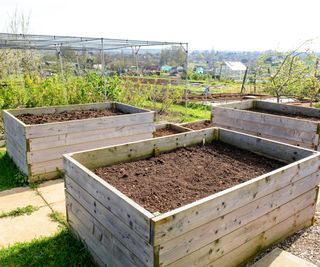You can use any type of material to create effective raised garden beds, but many people prefer wood. Wood is easy to work with and is a natural choice that is well suited to organic gardening. However, wood decomposes easily and may need to be replaced after a few years.
Other options include composite wood, metal, stone, and concrete block. When choosing a material, consider factors such as cost, ease of use, durability, and any chemicals that may leach into the soil. If you choose wood, you still have many options and considerations.
Does bed type matter when choosing the best wood for raised garden beds?
Pine is the most readily available, inexpensive, and easiest wood to work with for raised beds. The only real downside is that it rots easily and needs to be replaced frequently. If you are willing to replace it when necessary, pine is suitable for any type of raised bed.
Most types of wood are suitable for whatever you are growing in your raised beds. You may want to take extra precautions when choosing raised bed material for vegetables or other edibles, simply because any chemicals can leach into the soil and into the plants. To be clear, USDA organic certification guidelines do not allow pressure-treated wood to come into contact with food-producing plants.
What type of wood is best for raised bed gardens in each region?

(Image source: Westend61 / Getty Images)
Pine is a suitable wood for use anywhere, but consider using harder woods in hot, humid or rainy areas. Pine will deteriorate more quickly in these environments. Other woods will rot over time, but usually much more slowly.
You can try hardwoods like oak, but they may not last as long as pine and are more expensive. Redwood, cedar, and cypress are naturally resistant to pests and rot. However, they can be expensive and hard to find.
Also, consider the source of the wood when choosing a material for your raised bed. For example, West Coast cedar is a solid choice, but if you live in the eastern United States, it can be expensive. It’s also not the most sustainable choice.
What types of wood should not be used?
The best materials for raised beds are those that are affordable, easy to use, and sustainable. However, you should avoid treated wood. The U.S. Environmental Protection Agency (EPA) banned lumber treated with copper chromate arsenate in 2003. You’ll be hard-pressed to find any scrap wood old enough to have been treated with this toxic substance.
Modern treated wood is safer but is still not allowed for use in organic food production. The best wood for raised garden beds is not treated with these substances, but whether you want to use them in your garden is a personal choice. Current treatments are safer but can still leach into the soil and be absorbed by plants. One option when using treated wood is to place a plastic liner in the bed to prevent the wood from coming into contact with the soil.
Looking for scrap wood is a great way to save money, but stay away from old railroad tracks and telephone poles. They are treated with older, more toxic chemicals, including creosote.
What is the most durable wood for raised garden beds?

(Image source: tagphoto / Getty Images)
Cedar, redwood, black wattle, and cypress are the most durable, rot- and pest-resistant woods. Cedar raised beds are the most resistant, but all last longer than pine and most hardwoods.
How to protect wood so it lasts longer
The best wood sealant for raised beds is an oil-based stain. Another option is to cover the wood with heavy-duty garden plastic or line the bed with plastic. If you line the bed, be sure to provide drainage holes.
frequently asked Questions
Can recycled wood be used to make raised beds?
Reclaimed wood can be a great option. Just make sure it hasn’t been treated with harmful chemicals. Never use railway sleepers or telegraph poles.
What is the best way to secure wood in raised beds?
You can make a very sturdy raised bed by driving 2-inch by 2-inch (5 cm) stakes into the ground at the corners of the bed. Use nails or screws to secure the wooden sides of the bed to the stakes.
